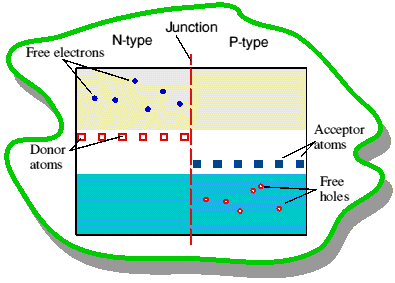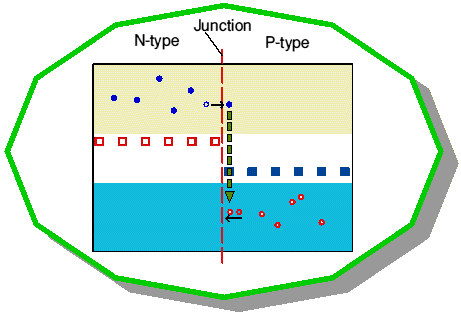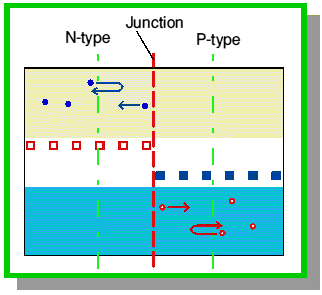
To understand how a pn-junction diode works, begin by imagining two
separate bits of semiconductor, one n-type, the other p-type.


Bring them together and join them to make one piece of
semiconductor which is doped differently either side of the junction.

Free electrons on the n-side and free holes on the p-side can
initially wander across the junction. When a free electron meets a free hole it
can 'drop into it'. So far as charge movements are concerned this means the hole
and electron cancel each other and vanish.

As a result, the free electrons near the junction tend
to eat each other, producing a region depleted of any moving charges. This
creates what is called the depletion zone.

Now, any free charge which wanders into the depletion zone finds
itself in a region with no other free charges. Locally it sees a lot of positive
charges (the donor atoms) on the n-type side and a lot of negative charges (the
acceptor atoms) on the p-type side. These exert a force on the free charge,
driving it back to its 'own side' of the junction away from the depletion zone.
The acceptor and donor atoms are 'nailed down' in the solid
and cannot move around. However, the negative charge of the acceptor's extra
electron and the positive charge of the donor's extra proton (exposed by it's
missing electron) tend to keep the depletion zone swept clean of free charges
once the zone has formed. A free charge now requires some extra energy to
overcome the forces from the donor/acceptor atoms to be able to cross the zone.
The junction therefore acts like a barrier, blocking any charge flow (current)
across the barrier.

Usually, we represent this barrier by 'bending' the
conduction and valence bands as they cross the depletion zone. Now we can
imagine the electrons having to 'get uphill' to move from the n-type side to the
p-type side. For simplicity we tend to not bother with drawing the actual donor
and acceptor atoms which are causing this effect!
The holes behave a bit
like balloons bobbing up against a ceiling. On this kind of diagram you require
energy to 'pull them down' before they can move from the p-type side to the
n-type side. The energy required by the free holes and electrons can be supplied
by a suitable voltage applied between the two ends of the pn-junction diode.
Notice that this voltage must be supplied the correct way around, this pushes
the charges over the barrier. However, applying the voltage the 'wrong' way
around makes things worse by pulling what free charges there are away from the
junction!
This is why diodes conduct in one direction but not the other.
Electronics
homepage
Course
contents
 Content and pages maintained by: Jim Lesurf (jcgl@st-and.ac.uk)
Content and pages maintained by: Jim Lesurf (jcgl@st-and.ac.uk)
using HTMLEdit2 on a
StrongARM powered RISCOS machine.
University of St. Andrews, St Andrews, Fife
KY16 9SS, Scotland.







